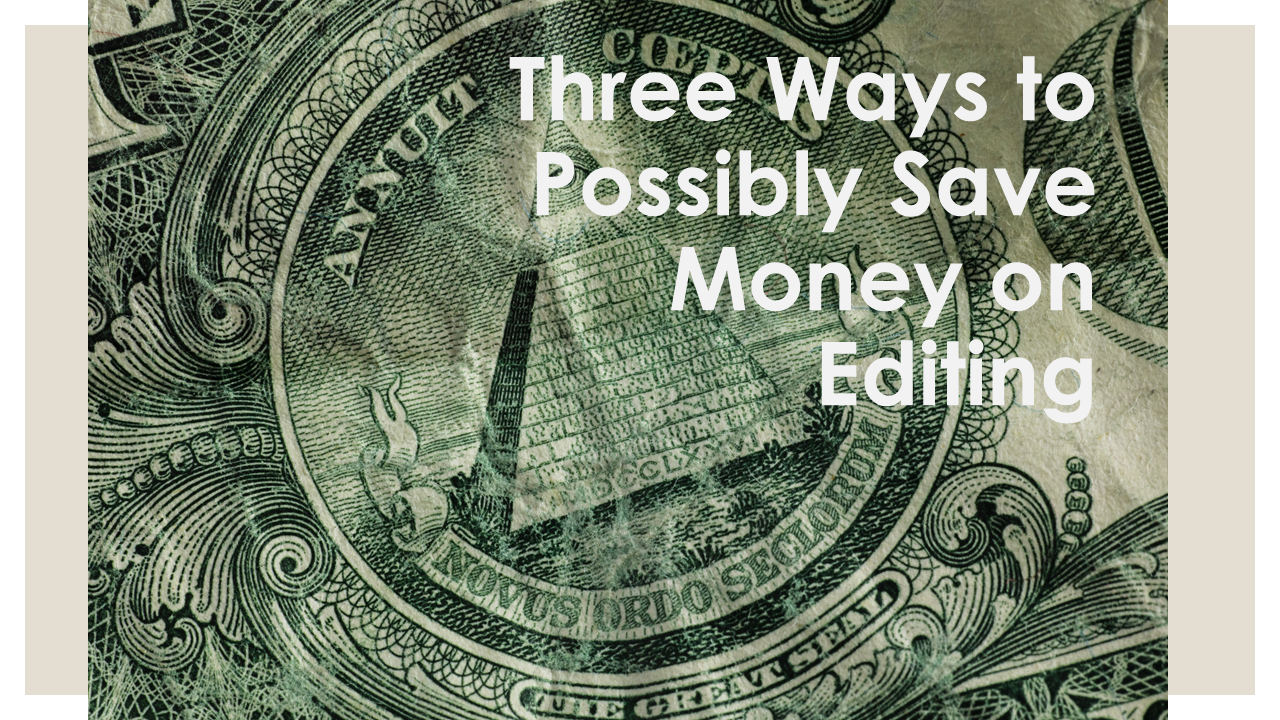The Write Stuff
Ideas & Thoughts About WritingThree Easy Ways to Possibly Save on Editing

Consider These Simple Ways to Polish Your Writing
There are no two ways about it; good editing for any book costs money. If you are a self-published author, this expense falls to you. Depending on the length and complexity of your manuscript, the cost is usually over $500 for a novella and ranges up to $2,000 and more for a novel-length manuscript.
Some freelance editors, like me, do not have one set per-word price, preferring to give a range for each particular editing service. For instance, my copyediting starts at 1.6 cents per word and goes up from there. How do I determine what to charge an author for a particular book? I look over the entire manuscript, noting a variety of things that chew up my editing time, including grammar and punctuation issues, misspellings, formatting problems, and the number of items I will have to research. Then I come up with a number that I believe will compensate me adequately for the work to be done.
Your book may or may not be light or heavy in items that need researching; that depends on your topic for nonfiction and the background for fiction. But the author can control several of these factors. Namely, the author can decrease errors in grammar, punctuation, usage, and spelling. The writer also has control over other particular errors that tend to creep into a manuscript like accidental additions or deletions of words during self-editing.
Here are three easy ways to get on top of the kind of mistakes you can correct that may also allow your editor to price your editing job at the low end of her range. Now, of course, a fraction or two of a penny per word doesn’t sound like a lot of savings, but in manuscripts of 75,000 to 100,000 words, fractions of a penny add up.
Without further ado, here are three simple things you can do to save on editing costs.
NUMBER ONE — Use a Heavy-Duty Spelling and Grammar Checker
Run your entire manuscript through a grammar/spelling checker like Grammarly. I actually require my authors to do this before I edit their work. I use Grammarly myself, and I particularly adore it because I can use it right in Word to analyze and correct my writing. Not only does Grammarly point out and make suggestions about possible errors, sometimes the error flag has a drop-down card that will explain that particular point of grammar to you. (By the way, Grammarly has both free and paid options.) Now, of course, a software-based checker is not 100% accurate. It misses some errors, and it sees some perfectly fine text as a mistake when it is not. So, you still need to have a good background in grammar to know what to accept and what to ignore. If you are planning to pass your manuscript along to an editor, leave any questionable changes to him or her. Change only what you’re certain of.
NUMBER TWO — Use Word’s Read Aloud Function
Time to sit back and relax! Okay, not completely relax. Rather, use Word’s Read Aloud function available on the Review tab to read your story back to you. Even after the time you spent pouring over your manuscript, you will be amazed at the number of mistakes that your eyes missed but your ears can hear. And it certainly isn’t the same as reading it to yourself. The slightly unnatural speech of the robotic text will ring differently in your ears than your own voice. It will uncover awkward phrases–which won’t help so much with editing costs as with more pleased readers–and alert you to extra or wrong words and point out missing ones. And, unlike you, Word’s voices never get tired of talking! Even a long manuscript doesn’t take long for Word to read back. Expect it to take about an hour or so for 25 to 35 double-spaced full pages, depending on how often you have to stop to fix errors. These hours will bear strong dividends.
NUMBER THREE — Clean Up Dialogue
All right, I’ll admit, this one isn’t as easy as the first two, but this is the one that–for a couple of hours of your time–might save you a lot of money. One of the most significant areas that I find needs correction is punctuation around fiction dialogue. If you don’t have a firm grasp of this, your editor will most likely have to charge in the higher range of their fees. Why? In fiction, most scenes have a lot of dialogue. If you’re making the same mistakes with dialogue every paragraph or so, that is a LOT of work for the editor.
(Quote examples below come from A Christmas Carol by Charles Dickens and Pride & Prejudice by Jane Austen.)
Despite the struggle authors have with this, the rules around punctuation for dialogue aren’t that difficult. Here are some basic rules. Follow these, and your editor will be happy!
If your line of dialogue stands alone, it just needs beginning capitalization and terminal punctuation–all enclosed in quotation marks.
“Certainly, sir; and it has the advantage also of being in vogue amongst the less polished societies of the world. Every savage can dance.”
Dialogue doesn’t often ride alone in modern writing. The prose around dialogue in the same paragraph is either a dialogue tag (she said or he explained) or a description of a character’s thoughts or actions.
Actions or thoughts of a character need their own sentence(s). An action or thought alone cannot act as a dialogue tag. For any non-quote-enclosed sentence in the same paragraph as dialogue that isn’t a dialogue tag, make sure to have starting capitalization and appropriate ending punctuation (period, question mark, or exclamation point).
Mrs. Reynolds anticipated Miss Darcy’s delight when she should enter the room. “And this is always the way with him,” she added. “Whatever can give his sister any pleasure, is sure to be done in a moment. There is nothing he would not do for her.”
Ah, those pesky dialogue tags! Punctuating around dialogue tags is not as straightforward. Tags can come before or after a line of dialogue–and can even be nested in the middle of a dialogue sentence.
A leading dialogue tag ends with a comma before capitalized, in-quotation-marks dialogue.
Scrooge seemed uneasy in his mind and answered briefly, “Yes.”
An ending dialogue tag is only capitalized at the beginning when a proper name starts it (like the character’s name). Otherwise, use lower case.
“You are dancing with the only handsome girl in the room,” said Mr. Darcy, looking at the eldest Miss Bennet.
If you use an ending dialogue tag, be sure to use a comma (not a period) within the quoted dialogue. Think of the dialogue tag as completing the piece of dialogue; you wouldn’t have two periods in one sentence. Of course, you can use question marks and exclamation points within the quotation–but never use a period at the end of quoted dialogue when an ending dialogue tag exists.
“On the wings of the wind,” replied the Ghost.
“God bless us every one!” said Tiny Tim, the last of all.
Comma-bound nested dialogue tags–which interrupt a line of dialogue–should ONLY occur in the middle of a dialogue sentence. If there are full sentences on either side of the dialogue tag, that tag needs a period (not a comma), and the dialogue that follows should be capitalized.
“My dear Mr. Bennet,” said his lady to him one day, “have you heard that Netherfield Park is let at last?”
“Christmas a humbug, uncle!” said Scrooge’s nephew. “You don’t mean that, I am sure?”
One other small point: Don’t confuse the idea of nested dialogue tags with nested dialogue–where a sentence or two of dialogue is bracketed with double dialogue tags or a dialogue tag and an action phrase. In most cases, this should be avoided at all costs–unless just a word or two of dialogue is nested; consider recasting the sentence. Don’t write: Helena strode to the door before turning around and saying, “I will not be threatened, Jeffrey! If you thought there was any way I would let you get away with this, you’re wrong!” and then left, the door frame reverberating after she’d gone. (Yes, I have seen sentences like this!)
With these rules in mind, look at the dialogue paragraphs of your manuscript. You can even use Word’s Find function to highlight quotation marks for you, and then you can just scan down a page looking at punctuation around the marks. Correct any mistakes the grammar checker did not. The good news? If you spend time like this on one manuscript, you’ll be much more aware the next time you self-edit your next manuscript so that you’ll have less of this tedious work to do at the end!
I hope you find these suggestions useful, whether or not they save you money with editorial services!






Recent Comments